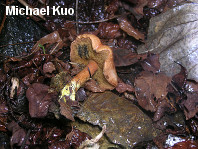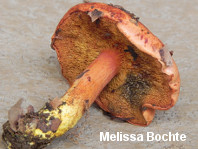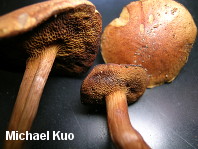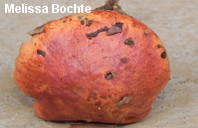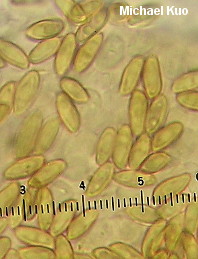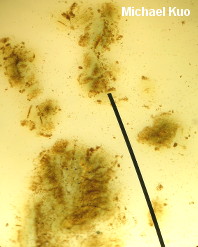| Major Groups > Boletes > Red-Pored Boletes > Chalciporus piperatoides |

|
Chalciporus piperatoides [ Basidiomycota > Boletales > Boletaceae > Chalciporus . . . ] by Michael Kuo Similar to the better known Chalciporus piperatus, Chalciporus piperatoides is also a drab, pinkish tan bolete with a reddish pore surface, yellow basal mycelium and a peppery to bitter taste. Unlike its cousin, however, Chalciporus piperatoides bruises blue, and features an olive (rather than brown) spore print. Microscopic differences include smaller spores for Chaliciporus piperatoides, along with a faint greenish-blue reaction of the tubes to Melzer's reagent. Chalciporus piperatoides was originally described from an oak forest in Michigan, and is apparently widely distributed in North America and associated with a wide variety of trees--although this may be an indication that several cryptic species are actually involved. Boletus piperatoides and Suillus piperatoides are synonyms. Description: Ecology: Mycorrhizal with hardwoods and conifers; growing alone, scattered, or gregariously; summer and fall (also over winter along the West Coast); possibly widely distributed, but more common in northern and montane areas. Cap: 3-8 cm; convex or slightly conic, becoming broadly convex; sticky when fresh, but soon dry; bald or very finely velvety when young; shiny; dull red to reddish brown or dull pinkish tan, fading to tan. Pore Surface: Dull brownish orange to dull reddish; bruising blue, then slowly resolving to dark reddish brown; 1-2 pores per mm near the margin and when young, becoming larger and irregular to angular near the stem and with age; tubes to 5 mm deep. Stem: 4-8 cm long; 0.5-1.5 cm thick; more or less equal; dry; colored like the cap; bald; base with bright to dull yellow mycelium. Flesh: Yellowish in the cap; brighter yellow in the stem; bluing erratically when sliced, or not bluing. Odor and Taste: Odor not distinctive; taste strongly peppery or bitter. Chemical Reactions: Ammonia reddish brown on cap surface; brownish on flesh. KOH black on cap surface; brown on flesh. Iron salts negative on cap surface; negative on flesh. Spore Print: Olive. Microscopic Features: Spores 6-8 x 2.5-3.5 µ; smooth; subfusoid; yellowish in KOH. Hymenial cystidia fusoid to fusoid-ventricose; to about 75 x 12 µ. Trama of tubes faintly and erratically greenish-amyloid when dried specimens are studied. Pileipellis a tangled layer of cylindric elements 6-12 µ wide; terminal elements with rounded to subacute apices; hyaline to yellowish. REFERENCES: (Smith & Thiers, 1971) Baroni & Both, 1991. (Smith & Thiers, 1971; Smith, Smith & Weber, 1981; Baroni & Both, 1991; Both, 1993; Bessette, Roody & Bessette, 2000; Roody, 2003; McNeil, 2006.) Herb. Kuo 07171007, 07111203. This site contains no information about the edibility or toxicity of mushrooms. |
© MushroomExpert.Com |
|
Cite this page as: Kuo, M. (2013, December). Chalciporus piperatoides. Retrieved from the MushroomExpert.Com Web site: http://www.mushroomexpert.com/chalciporus_piperatoides.html |
